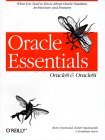| Delphi Clinic | C++Builder Gate | Training & Consultancy | Delphi Notes Weblog | Dr.Bob's Webshop |
| Delphi Clinic | C++Builder Gate | Training & Consultancy | Delphi Notes Weblog | Dr.Bob's Webshop |
| ||||||
 |
Title: Author: Publisher: ISBN: Info: |
Oracle Essentials - Oracle 8 & Oracle 8i Rick Greenwald, Robert Stackowiak & Jonathan Stern O'Reilly 1565927087 500 pages (no CD-ROM) |
This book gives a concise description of the Oracle database architecture, and the features which are present in Oracle 8 and Oracle 8i.
It is divided into 14 chapters and has 355 pages. The first chapters of the book give an introduction to relational databases and Oracle in particular, followed by a description of the Oracle 8 architecture. These chapters might be interesting to read if you have never seen a database before, otherwise they are basic knowledge. Next comes a chapter about installing and running an Oracle database which is a subject that others write an entire book about, and unfortunately is only 24 pages here. The next chapter deals with the datatypes known to Oracle, from basic datatypes like DATE and NUMBER to additional datatypes like BLOB and CLOB. This chapter again contains quite some useful information for a novice Oracle user. Then comes a chapter which talks about the managing of an Oracle database and is mainly about the Oracle Enterprise Manager. Again a lot of topics here, which are not covered extensively though.
The second part of the book talks about some DBMS related issues and how Oracle has solved these. The first topic to be discussed in this part is multiuser concurrency which is one of the key problems which has to be solved in a DBMS. The writers explain the basics regarding multiuser concurrency and give a detailed example on how Oracle handles this. Next is a chapter about OLTP (OnLine Transaction Processing) followed by a chapter about Data Warehousing. These two chapters are quite good if you want to get a clear description of these two practices of an Oracle dabatase, and if you want to know the differences in terms of e.g. performance issues.
The last part of the book contain, in my opinion, some random topics like High availability, hardware architecture - i.e. Uniprocessor systems, Symmetrical Multiprocessing Systems, Clusters, Massively Parallel Processing systems, and NUMA systems - distributed databases and distributed data, and how to handle transactions in such an architecture using two-phase commits, Oracle 8/8i extensions such as Time Series, Spatial Option and interMedia, and finally Oracle8i and the web, which deals with the capabilities Oracle can provide in the separate tiers in an internet enabled architecture. If you want to get a better understanding on any of these topics I would advice you to read the appropriate chapter(s).
A minor negative remark regarding this book would be that it contains a lot of references from one chapter in the book to other chapters in the book. This makes reading a bit difficult since you tend to leaf through the book a lot, and does not make the book very useful as a reference guide. Also the thread running through the book is difficult to find, as the topics seem to have been added at a somewhat random basis. These negative remarks aside, I would suggest this book to readers who already have some knowledge about DBMS's, as it might be a bit too concise to give it to a novice. However it is a very good starting point if you want to get a more in depth description regarding the topics discussed in this book. This is amongst others because the appendix of the book contains a lot of additional resources which you can later on read if you need more information on a specific topic.
(Arjan Jansen)
|
|

| More Book Reviews |

|
|